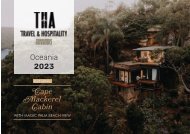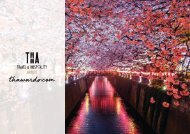Create successful ePaper yourself
Turn your PDF publications into a flip-book with our unique Google optimized e-Paper software.
<strong>Travel</strong> <strong>Innovation</strong>, <strong>Design</strong> & <strong>Technology</strong><br />
<strong>2020</strong>
TEAM<br />
CEO<br />
Robert Bruce<br />
EDITOR-IN-CHIEF<br />
Katherine Lozell<br />
ART DIRECTOR<br />
Marcs Bacera<br />
DIRECTOR OF SALES<br />
Stanley Lucas<br />
AWARDS DIRECTOR<br />
Brian Anson<br />
EDITORIAL LIAISON MANAGER<br />
David Hyde<br />
DIRECTOR OF MARKETING<br />
Azim Aftab<br />
SENIOR WRITERS<br />
Aisha Ahmed<br />
Jacqui Irvine<br />
Joseph Wilton<br />
Tasmai Dave<br />
SENIOR DESIGNERS<br />
Antoine Jackson<br />
Hafiz Arslan<br />
AWARDS MANAGERS<br />
Adam Cole<br />
Alice Smith<br />
Joyce Lee<br />
Peter Clement<br />
Zach Ford<br />
RESEARCH MANAGERS<br />
Jerald Jaime<br />
Mukul<br />
Contents <br />
Criteria 4<br />
<strong>Technology</strong> Trends 6<br />
<strong>Travel</strong> with out travelling? 10<br />
<strong>Travel</strong> & Blockchain: Is there use case? 14<br />
Value of Guest Engagement Platforms 18<br />
WeBee 22<br />
Innovative Marketing 24<br />
3Sixty Digital 28<br />
Top 5 Hotel Architecture 30<br />
Interior <strong>Design</strong> Bold Minimalist Vs Magnificent Maximalist 34<br />
2 3
CUSTOMER SERVICE<br />
STYLE & DESIGN<br />
MENU & DISHES<br />
MARKETING & BRANDING<br />
DIVERSITY<br />
LOCATION CUSTOMER REVIEWS VALUES & APPROACH<br />
Excellence in Service is an important<br />
category, as customer service can<br />
often responsible for repeat diners.<br />
We look for restaurants where<br />
staff go out of their way to please<br />
their guests, those that provide a<br />
It is no question that style and<br />
design is key factor in selecting<br />
our award winners. A guest will<br />
form an opinion about a restaurant<br />
as soon as they arrive, so it is<br />
important to us that all our winners<br />
personal level of service and take make those first impressions<br />
the time to get to know each visitor<br />
so that they might anticipate their<br />
every need. This can be something<br />
as simple as a friendly conversation,<br />
a manager who offers a personal<br />
greeting or a chef who is happy to<br />
adjust based on dietary needs –<br />
but whatever it is, we are always<br />
pleased when we encounter staff<br />
that have been trained in the art of<br />
customer satisfaction.<br />
count. We’re certainly not partial<br />
to a specific period of architecture<br />
– but whether we’re judging a<br />
gothic castle or an environmentally<br />
friendly lodge, the criteria remains<br />
the same. We consider factors<br />
such as architectural features, use<br />
of materials, creation of spaces,<br />
décor and the overall feel. We love<br />
it when we find a restaurant that<br />
tells a story though its interior and<br />
exterior features or offers a design<br />
that is sympathetic to the natural<br />
Criteria<br />
surroundings of its location.<br />
<br />
While the ambience and services<br />
of a restaurant are important, what<br />
really defines it is its menu and the<br />
dishes in it. We pay special attention<br />
to the courses that are available in<br />
the menu and even look into how<br />
it’s set up. Balance of the menu is<br />
especially important. A restaurant<br />
that serves multiple dishes that<br />
balance each other out to give<br />
the customers a perfect meal<br />
experience is seen as an authority.<br />
The cuisine options are taken into<br />
consideration too; be it a local<br />
cuisine or an international one. The<br />
sourcing of the ingredients is an<br />
important factor as well.<br />
In today’s modern age, a restaurant<br />
cannot rely on word of mouth to get<br />
their message out into the world.<br />
As social media has be<strong>com</strong>e a vital<br />
part of everyday life, we like to see<br />
<strong>com</strong>panies that go the extra mile<br />
to engage with their customers,<br />
both past and future. Attractive and<br />
informative websites and engaging<br />
and honest content are what we<br />
look for when judging a <strong>com</strong>pany’s<br />
use of marketing; how well they<br />
display their services, how up-todate<br />
their content is, how well they<br />
get their brand message across,<br />
and, most importantly, how well<br />
their marketing can tempt us to go<br />
and see what they have to offer for<br />
ourselves.<br />
Diversity is one important aspect<br />
that needs to be taken into<br />
consideration when in the travel and<br />
hospitality industry. It is essential to<br />
have staff that has varying diversity<br />
to ensure that the organization can<br />
properly connect with their guests.<br />
Diversity is taken into account in<br />
terms of gender, nationality as well<br />
as languages spoken among other<br />
factors. Not only do we take the<br />
diversity of the staff into account<br />
but even that of the facilities and<br />
services offered; a hotel or tour<br />
operator providing a better range of<br />
services is preferred over those that<br />
do not.<br />
Location is one of the most<br />
important factors, but also one of<br />
the most subjective, as the ‘ideal’ is<br />
very much determined by the type<br />
of visitor and the type of restaurant<br />
itself. However, there are a few<br />
factors we take into consideration<br />
when determining the winners of<br />
location-based awards. The first<br />
is convenience; that is, restaurants<br />
that are easy to travel to. Many of<br />
our winners in this category are<br />
in convenient locations, such as<br />
adjacent to popular attractions,<br />
close to beaches or found in the<br />
heart of easy-to-navigate cities.<br />
We’re always excited to <strong>com</strong>e<br />
across a restaurant that is, to use<br />
a familiar phrase, off-the-beatentrack.<br />
A restaurant that can offer<br />
something a little different, in<br />
terms of natural surroundings,<br />
can make the difference between<br />
a good dining experience and an<br />
incredible one.<br />
What better way is there to know<br />
about an organization than<br />
by getting first hand reviews?<br />
Customers are the best judges of<br />
any service as they are the ones<br />
who experience them and can<br />
assess whether they were up to the<br />
mark or not. Considering reviews<br />
from hundreds of customers over a<br />
set period gives us a fair idea about<br />
the general pros and cons of any<br />
organization while also giving us<br />
valuable inputs for the other criteria<br />
as well.<br />
The approach taken by the<br />
restaurant whether it be Innovative,<br />
traditional or anything else are<br />
considered when deciding winners.<br />
Values and approach illustrate<br />
the dedication of the restaurant to<br />
deliver a specific type of experience<br />
for their diners. This is evident in the<br />
food, source menu, presentation,<br />
the staff and<br />
4 5
<strong>Technology</strong> Trends<br />
The remarkable rise of the internet<br />
over the last two decades has had<br />
a profound effect on the development<br />
of new and exciting technology that<br />
has positively enhanced the industries<br />
of hospitality and tourism. In the last<br />
decade especially, the use of Information<br />
<strong>Technology</strong> in the travel industry has<br />
been pivotal in the reduction of overall<br />
costs and improvement of customer<br />
satisfaction. With the travel sector being<br />
one of the most profitable in the world<br />
and one that is continuously expanding,<br />
it is critical that businesses keep upto-date<br />
with the latest technological<br />
advancements. We have outlined below<br />
three of the most popular tech trends<br />
currently gaining a lot of traction.<br />
Artificial Intelligence (AI)<br />
Although the term might bring to mind<br />
futuristic dystopian landscapes ruled<br />
by robots that have enslaved humanity,<br />
AI is in fact regularly embedded within<br />
the travel and hospitality industry.<br />
Simply put, it refers to <strong>com</strong>puterised<br />
programs that can learn to carry out<br />
tasks that would normally require<br />
human intelligence to perform. This<br />
has the enormous potential to save<br />
businesses money and effort by<br />
making it possible for tasks to be<br />
performed around the clock in very<br />
little time.<br />
AI-enabled platforms without the<br />
use of dedicated human staff have<br />
be<strong>com</strong>e the norm and are currently<br />
part of most online booking systems<br />
in the form of chatbots or virtual<br />
assistants. And given that AI systems<br />
naturally improve their knowledge<br />
base by learning from customers’<br />
behaviour, they can be used to provide<br />
a more personalised travel experience.<br />
And the application of AI in the<br />
travel sector is not confined to the<br />
field of customer services. More<br />
and more <strong>com</strong>panies are using<br />
intelligent systems to automate<br />
most of their onerous data analysis<br />
and management projects and<br />
draw conclusions about business<br />
performance.<br />
6 7
Recognition <strong>Technology</strong><br />
Recognition technology is currently<br />
taking the travel industry by storm.<br />
Facial and fingerprint recognition is<br />
widely available worldwide and helps<br />
streamline passengers’ journeys and<br />
reduce unnecessary waiting times.<br />
Biometric identifiers are now also used<br />
in some hotels to allow a smoother,<br />
more personalised check-in process as<br />
well as provide access to rooms without<br />
the need for key cards by simply using<br />
fingerprints.<br />
Facial recognition can also help<br />
improve overall security protocols by<br />
identifying guests’ identity and allowing<br />
or forbidding access to certain places.<br />
But surely one of the most exciting<br />
functions of recognition technology<br />
is the ability to <strong>com</strong>plete payments<br />
without the need for cash or even credit<br />
card.<br />
Immersive Visual Experiences<br />
Virtual Reality (VR) and<br />
Augmented Reality (AR) are<br />
two trends that have exploded<br />
in the tech industry and are<br />
now also being applied in the<br />
travel sector. They are currently<br />
being used for virtual simulation<br />
of travel destinations and<br />
ac<strong>com</strong>modations- a type of<br />
very realistic ‘try before you<br />
buy’ experience. Recent studies<br />
have shown that enhancing the<br />
pre-booking experience with<br />
VR or AR has shown a 40%<br />
return on investment, making<br />
this a very promising option for<br />
the future of travel. Even more<br />
interestingly, VR can help users<br />
immerse themselves in a digital<br />
environment when, for whatever<br />
reason, they are unable or<br />
unwilling to travel.<br />
8 9
<strong>Travel</strong> with out<br />
travelling?<br />
Immersive visual experiences such as<br />
Augmented Reality (AR) and Virtual<br />
Reality (VR) are the latest creative<br />
additions to the ever-expanding industry<br />
of travel and hospitality. These trends<br />
have <strong>com</strong>e a long way in a relatively<br />
short time in the tech industry and are<br />
usually associated with video games<br />
where users can immerse themselves<br />
in a virtual world and even manipulate<br />
objects and engage in certain actions.<br />
VR hardware has seen a dramatic drop<br />
in price in the last 5 years and this has<br />
started to increase accessibility and<br />
use.<br />
But how exactly are immersive visual<br />
experiences apply to travel and tourism?<br />
Does it work and is it a trend that is likely<br />
to be profitable?<br />
In a recently published Adventure Trends Report,<br />
VR was amongst the most popular trends in the<br />
travel industry, although its development is still<br />
at its infancy. With the need of consumers to buy<br />
‘experiences’ rather than products on the rise,<br />
VR offers a potentially attractive way of allowing<br />
customers a ‘test-drive’ before they pay. Imagine<br />
being able to climb the top of a snowy mountain<br />
or scuba dive alongside manta rays deep in the<br />
Red Sea- without ever having to leave your living<br />
room.<br />
10 11
The industry often refers to the<br />
functions known as the ‘3 Es’:<br />
Enabling, Escaping and Enriching. At its<br />
current state of developing, Enabling<br />
is by far the most obvious function<br />
of VR and it usually applies to the<br />
very early stages of the customer’s<br />
journey. <strong>Travel</strong>lers spend a lot of time<br />
researching, googling images and<br />
videos of particular places but VR does<br />
away with that. Planning ahead using<br />
VR might help reduce disappointment.<br />
Many <strong>com</strong>panies already offer AR<br />
versions of their products, be them<br />
hotel rooms or travel experiences,<br />
that can simply be accessed by the<br />
customer’s smartphone. Escaping<br />
can help customers literally escape<br />
from mundane long journeys and<br />
unpleasant experiences by immersing<br />
themselves in whatever VR has to offer.<br />
And Enriching refers to enhancing the<br />
traveller’s experience once they are<br />
already at their destination.<br />
One of the most exciting possible uses for VR is<br />
to cater for those who are unable to travel. Some<br />
<strong>com</strong>panies are currently experimenting with<br />
attending to the sense of wanderlust of those<br />
who cannot visit destinations far away maybe<br />
due to health or mobility reasons. From a more<br />
ethical perspective, it can even help with overtourism<br />
as customers can visit places without<br />
actually being physically there.<br />
But there are potential downsides as well. VR programs and platforms<br />
can be very costly to develop and implementation and investment<br />
can be a considerable risk given that there is no real hard data about<br />
their overall usefulness or customer popularity yet. And there may a<br />
paradoxical side effect too: if virtual reality can someday provide an<br />
inimitable travel experience without the need to actually travel, how<br />
much of a threat is this to the travel industry? Might it stop customers<br />
from spending thousands of dollars on booking planes, hotels and<br />
experiences?<br />
It’s early days yet for VR in the travel industry but it’s certainly a trend<br />
to keep an eye on.<br />
12 13
<strong>Travel</strong> & Blockchain:<br />
Is there use case?<br />
Blockchain technology has<br />
revolutionised the way transactions<br />
are being carried out across the world. To<br />
simplify this rather convoluted concept we<br />
could say that ‘block’ refers to blocks of<br />
digital information and ‘chain’ is the public<br />
database where this information is stored.<br />
The digital information stored consists of a<br />
variety of data including transaction details<br />
(such as date, time, amount paid etc),<br />
and encrypted identity details with unique<br />
identifying codes for each block.<br />
One block can hold thousands of transactions.<br />
Once <strong>com</strong>plete, a block is stored on a<br />
database that is publicly available. Because<br />
of the way it is designed, a blockchain is<br />
very hard to crack and therefore less prone<br />
to hacking. It is decentralised, which means<br />
that no single person has more control over<br />
this information than anyone else. So in<br />
order for a transaction to be accepted, it has<br />
to be verified by every single member that<br />
has access to that particular chain. This is<br />
currently changing the way we think about<br />
information storage and offers a promising<br />
solution to serious security breaches.<br />
Applications to the travel industry<br />
Planning and paying for a trip require the uploading of very sensitive, personal<br />
information on different online platforms such as booking agents, airline<br />
<strong>com</strong>panies or ac<strong>com</strong>modation providers. Information such as bank and<br />
passport details are regularly sent to different online <strong>com</strong>panies and whether<br />
they like it or not, customers place a lot of trust in this process. Only last year,<br />
5 million passport numbers were stolen from a top international hotel chain,<br />
further calling into question our current security paradigm. Blockchain could<br />
potentially make this process a lot safer and more transparent given that this<br />
information is stored in a way that makes it almost impossible to alter or hack<br />
into, so both financial transactions and the storage of information be<strong>com</strong>e<br />
simplified and more secure.<br />
Security aside, the aspect of having<br />
a decentralised service means that<br />
there is no need for intermediaries.<br />
Although online booking agents<br />
offer customers to browse through<br />
thousands of hotels or flights,<br />
<strong>com</strong>panies often pay at least<br />
15% <strong>com</strong>mission to be able to be<br />
advertised on such platforms. By<br />
taking out the middle man, service<br />
providers can minimise associated<br />
fees and connect directly with<br />
customers.<br />
14 15
Identification and Tracking<br />
Ever had the displeasure of arriving at<br />
your destination only to find out that<br />
your luggage didn’t? Cue endless hours<br />
of frustration, waiting to discover where<br />
your suitcase ended up in. Luggage<br />
often changes many hands especially<br />
during longer trips and Blockchain can<br />
make it easy and transparent to trace it<br />
at all times<br />
Blockchain could also enhance<br />
customers’ identification process during<br />
travel, which is often a time-consuming<br />
and onerous process. This technology<br />
has the potential to drastically reduce<br />
waiting and standing times at airport<br />
queues.<br />
It is yet to be seen whether Blockchain<br />
will take over and disrupt the travel<br />
industry as we currently know it.<br />
Judging by how other tech trends have<br />
already started making an impact, it<br />
may not be that long before we see it<br />
change the way we think about travel<br />
altogether.<br />
16 17
Value of Guest<br />
Engagement Platforms<br />
Customer satisfaction is the<br />
number one predictor of<br />
successful sales revenue. With the<br />
staggering rise of social media over the<br />
last 2 decades, more and more salesrelated<br />
interactions take place on online<br />
social platforms. Traditional telephone<br />
and even email <strong>com</strong>munications are<br />
being slowly phased out and replaced<br />
with more technologically savvy, often<br />
automated intelligent interaction<br />
systems. In this fast-changing online<br />
universe, customers’ <strong>com</strong>plex multidimensional<br />
needs remain the highest<br />
priority.<br />
Customer Engagement Platforms<br />
are the newest tech trend arrival set<br />
to revolutionise the way different<br />
types of businesses interact with their<br />
customers.<br />
What is a Customer<br />
Engagement Platform?<br />
Also known as Guest Engagement Platforms,<br />
these are <strong>com</strong>prehensive systems that help<br />
centralise the entire journey of a customer’s<br />
experience, even past the sales point. The aim<br />
of such a platform is two-fold. First, it serves as<br />
a way of optimising customers experience and<br />
offering them a superior service, tailormade<br />
to their specific requirements. Second, it<br />
enhances businesses’ operational efficiency<br />
and reduces associated costs, therefore<br />
maximising revenue.<br />
You can expect a Guest Engagement Platform<br />
to contain a range of tools including email,<br />
chat, social media, calendars and notes. It<br />
is a way of efficiently organising customer<br />
data and can be designed to offer real-time<br />
response to customers’ needs. They have<br />
integrated intelligent tools including behaviour<br />
analysis and virtual assistants that are able to<br />
contextualise behaviour and offer appropriate<br />
solutions.<br />
Optimising Customer Experience<br />
A business is nothing without satisfied, loyal customers. Engagement<br />
platforms strengthen the bond between business and customer in a<br />
variety of ways.<br />
– they can learn the customers’ pain points and address them effectively<br />
in very little time.<br />
– they can minimise effort on behalf of the customer and make whatever<br />
process smooth and<br />
– they offer a portal of instant response where customers can give<br />
feedback via the platform in real-time.<br />
18 19
Helping businesses perform<br />
better by:<br />
– providing automated data management<br />
saving time and cost<br />
– offering high-quality service across all<br />
domains of a customer’s experience.<br />
Practical Applications<br />
Webee Guest Engagement platform offers<br />
an all-inclusive tool that makes it possible<br />
to interact with guests in real-time during<br />
all stages of their journey. At the click of<br />
a button, guests can do anything from<br />
checking in to their toom without the need<br />
for key cards to arranging for laundry to be<br />
picked up on demand. The App is extremely<br />
intuitive making it easy and stress-free to<br />
use for both staff and guests who want a<br />
smooth experience. Mid-stay surveys is<br />
another function of the app (and one that<br />
is being adopted by many other online<br />
travelling platforms), giving customers<br />
the option to flag up any issues during the<br />
stay and allowing staff to iron out potential<br />
problems so that customer satisfaction<br />
is guaranteed and the relationship is<br />
strengthened further.<br />
Guest Engagement Platforms are<br />
be<strong>com</strong>ing increasingly popular<br />
with many well-known <strong>com</strong>panies<br />
already integrating them into their<br />
existing systems. With the current<br />
pace of technological innovation,<br />
such systems will likely replace<br />
older, outdated forms of customer<br />
interactions.<br />
20 21
Turkey Tel + <strong>www</strong>.getwebee.<strong>com</strong><br />
WeBee<br />
Europe | Guest Engagement Platform<br />
WeBee is a brand new Hotel solution that aims to strengthen Guest<br />
engagement. Specifically designed to take into account the busy rhythm of<br />
modern day life, WeBee does away with the middleman. It is no longer necessary<br />
for Guests to queue endlessly simply to check in their rooms. Remote check-in<br />
and keyless entry are just two of the many technological innovations available.<br />
WeBee makes it possible to interact with guests in real-time during all stages of<br />
their journey.<br />
From laundry requests, to room service and wake up calls, all is done via the App at<br />
the click of a button. Perfect for hardworking business people or tired visitors who<br />
want the smoothest experience possible. The App is extremely intuitive making it<br />
easy and stress-free to use for both staff and guests.<br />
WeBee gives Hotel Managers the<br />
ability to tailor-make interventions<br />
based specifically on their guests’<br />
wishes and behaviours. Guests<br />
can receive targeted offers and<br />
suggestions at any time during their<br />
stay and can modify those using the<br />
versatile platform from their phone,<br />
tablet or desktop.<br />
Satisfied customers leave satisfied<br />
reviews. WeBee mid-stay surveys<br />
ensure that your guest is <strong>com</strong>pletely<br />
pleased with the service they are<br />
receiving before it is time to check<br />
out. If anything is flagged-up as<br />
substandard, staff have the chance<br />
to rectify the situation immediately.<br />
This shows excellent customer<br />
service skills and improves the<br />
bond with the guest. Post checkout<br />
guests have the option to stay<br />
in touch via the app, increasing the<br />
likelihood of future engagement.<br />
22 23
Innovative Marketing<br />
Techniques<br />
Powerful marketing strategies<br />
are crucial to the success of any<br />
business no matter how big or small. They<br />
help identify and target specific audiences<br />
and develop profitable products. The<br />
unprecedented rise of digital marketing has<br />
made it possible for <strong>com</strong>panies to create a<br />
strong online presence by harnessing the<br />
benefits of a multitude of platforms, to both<br />
obtain new customers and deliver services<br />
to existing ones.<br />
The travel sector has a large audience<br />
with the global market generating over<br />
$1.3 trillion annually. Whereas less than 2<br />
decades ago people depended on travel<br />
agents or Teletext and took chances<br />
based on pictures they saw on brochures,<br />
today’s online platforms make it possible<br />
for customers to research extensively<br />
in a relatively short amount of time<br />
before buying. It is a well-known fact that<br />
people have hundreds of interactions<br />
with <strong>com</strong>panies while investigating travel<br />
destinations.<br />
From all the digital marketing platforms,<br />
social media is by far the biggest influencer<br />
and has changed the way people travel, with<br />
Facebook and Instagram being the Top 2<br />
most used platforms. Both offer a great deal<br />
of user engagement through different types<br />
of adverts, content promotion, live chats and<br />
visual stimulation. Facebook is fantastic for<br />
building brand awareness and ads are highly<br />
customisable to suit the different stages of the<br />
customer’s journey.<br />
Instagram is an equally powerful tool for building a following and many<br />
brands use it to regularly reach out to their audience. In fact, in a recent<br />
study, ‘Instagrammability’ was the most crucial factor for Millennials<br />
on choosing a holiday destination.<br />
Both platforms offer integrated video marketing options and according<br />
to studies, approximately 50% of users will actually act after watching<br />
a video ad.<br />
But irrespective of the platform used, perhaps the most important part<br />
of a <strong>com</strong>pany’s marketing strategy ought to be an awareness of the<br />
different phases of the customer’s journey.<br />
24 25
Stages of the Customer’s Journey<br />
Google analysed user behaviour and<br />
identified 4 key ‘micro-moments’, all of<br />
which are important entry-points for<br />
influencing a potential customer and<br />
eventually leading to a purchase<br />
Dreaming: this is the preliminary phase<br />
where there are no fixed plans and<br />
customers are browsing for ideas.<br />
This is quite an influential stage of the<br />
journey and first impressions of travel<br />
brands will really make an impact at this<br />
point.<br />
Organising: with a destination pinned<br />
down, customers are now in the<br />
process of choosing dates, flights and<br />
ac<strong>com</strong>modation. This is largely done<br />
through the use of search engines and<br />
travel brands ensure their website and<br />
products have a carefully optimised<br />
presence in the search results.<br />
Booking: with choices narrowed down, customers are now<br />
ready to book. This is a crucial moment and brands often<br />
make this as smooth a process as possible, with inviting<br />
call-to-action buttons and fast-loading pages.<br />
Experiencing: with the holiday now a reality, this is a more<br />
relaxed but still exciting part of the journey. <strong>Travel</strong> brands<br />
can offer a variety of options for ‘things-to-do’ while the<br />
customer is on their holiday.<br />
26 27
127 Hampton Rd, Bristol BS6 6JE, UK Tel + 44 117 911 3734 <strong>www</strong>.3sixty.co.uk<br />
3Sixty Digital<br />
United Kingdom | <strong>Travel</strong> Digital Agency<br />
We’ve inspired 1000’s of users to book<br />
holidays and travel experiences that they<br />
will never forget. We love the sector and<br />
want to help as many people as possible<br />
find their dream trip. We are here to make<br />
a difference, to drive results, and to inspire.<br />
<strong>www</strong>.instagram.<strong>com</strong>/3sixtystudio/<br />
<strong>www</strong>.twitter.<strong>com</strong>/3SixtyAgency<br />
<strong>www</strong>.facebook.<strong>com</strong>/3SixtyAgency/<br />
We create websites and digital solutions for travel brands and launch various<br />
travel products of our own. Our focus is on providing exceptional user<br />
experiences, which, in turn, ultimately drive <strong>com</strong>mercial performance.<br />
Over the past few years, this has led to a number of leading travel brands experiencing<br />
record-breaking years with 3Sixty at the fore. We are dedicated to helping brands<br />
boost website conversion, utilising digital platforms to improve team efficiencies,<br />
boosting travel brand profitability, and for all our clients, helping them produce the<br />
highest revenue-generating performance in their history.<br />
28 29
Architecturally<br />
Inspiring Hotels<br />
Though architectural design might<br />
not seem to be one of the top criteria<br />
for choosing a hotel or resort for most<br />
travellers, for the design-conscious<br />
customer it is a key priority, especially in<br />
the field of luxury travel. More and more<br />
people opt for upscale boutique hotels<br />
and elegantly refurbished properties<br />
instead of regular chain hotel stays.<br />
We’ve scoured the globe to bring you<br />
the Top 5 hottest designs.<br />
boasts floor-to-ceiling<br />
windows, <strong>com</strong>bining<br />
old Chiloé tradition with<br />
modern architecture.<br />
Portions of the hotel are<br />
raised on stilts to cause<br />
as little damage to the<br />
ground as possible<br />
and this gives the hotel<br />
an unusual, almost<br />
futuristic feel.<br />
Tierra Chiloé, Chile<br />
Perched in a prime location on the edge<br />
of a cliff on the island of Chiloé, this<br />
stunning hotel offers unprecedented<br />
views of the Chiloé archipelago lying<br />
just off the coast of Chile. The hotel’s<br />
distinctive architecture is in line with the<br />
stunning surroundings, with a wooden<br />
exterior that is reminiscent of the<br />
traditional churches in the vicinity. The<br />
hotel is situated on green, unspoiled<br />
pastoral hills with spectacular vistas of<br />
the nearby channel. The ground floor<br />
Hotel de Paris Monte Carlo, Monaco<br />
A well-known retreat frequented by the rich and famous, Hotel de Paris Monte Carlo reopened<br />
its doors in 2019, after an extensive 4-year renovation project. The property has retained its<br />
signature Belle Epoch façade, with lavish decorations reminiscent of by-gone eras of the late<br />
19th century. The Hotel now features upgraded lavish ac<strong>com</strong>modation including the new<br />
Princess Grace Suite, an extravagant 2-bedroom property arranged over two floors and featuring<br />
some of the Princess’ favourite items on display. Add to this a sea-facing glamorous SPA and<br />
a range of dazzling restaurants, it is easy to see why this place is a favourite of the crème de la<br />
crème.<br />
30 31
Park Hyatt, Bangkok<br />
Bangkok is a metropolitan city rife with<br />
spectacular high-risers offering one<br />
of the best skylines in the world. Park<br />
Hyatt offers a safe Haven high up in<br />
the sky, a protective sanctuary from<br />
the intensity of the urban jungle that<br />
is modern Bangkok. The architecture<br />
of the building is wonderfully irregular,<br />
with the steel exterior forming a threedimensional<br />
figure of 8 with curved<br />
corners while the interior is filled with<br />
free-form elements that exude an<br />
intimate and calming vibe.<br />
Al Bait, Sharjah<br />
Recently named UAE’s<br />
most luxurious resort, Al<br />
Bait <strong>com</strong>bines traditional<br />
heritage elements with<br />
features of contemporary<br />
architecture. This is a luxury<br />
escape that retains important<br />
archaeological findings of the<br />
area as part of its architectural<br />
structure and parts of the<br />
development are over half<br />
a century old. It <strong>com</strong>bines<br />
the traditional Arab feel with<br />
finer touches of luxury, paying<br />
homage to traditional Sharjah<br />
architecture, making this a<br />
very charming destination<br />
in an underrated part of the<br />
country.<br />
32 33
Interior <strong>Design</strong><br />
Bold Minimalist Vs<br />
Magnificent Maximalist<br />
Minimalism<br />
The minimalist movement in the field of<br />
architecture started in the 20 th century.<br />
It is a design that is characterised<br />
by austerity and parsimonious use<br />
of resources. ‘Less Is More’ is the<br />
overarching guiding principle. It aims<br />
to retain only essential elements and<br />
do away with anything unnecessary.<br />
Ludwig Mies van der Rohe is the German<br />
architect first credited with outlining the<br />
basic principles of the movement. He<br />
advocated the use of modern materials<br />
such as steel and glass and promoted<br />
the idea of large, open spaces designed<br />
in strict geometric shapes. This concept<br />
draws attention to the few elements<br />
used and makes them stand out more.<br />
Minimally designed interiors are often defined by simple, often black and white<br />
or at most binary colour palette. Furniture is usually designed in very simple<br />
geometric shapes and monochromatic tones. Spaces tend to be open plan<br />
and without partitions and often feature clever storage solutions. For example,<br />
cabinets and shelves can easily be built in or attached to walls, thus saving space.<br />
Because of its simplicity, minimalist design has gained a lot of popularity in recent<br />
years. There are obvious benefits to this trend. Minimalism is all about ‘trimming<br />
unnecessary fat’ and is therefore beneficial for anyone without much space<br />
to spare. In that way, smaller scale hotels can make the most use of space by<br />
reducing clutter and creating a more spacious interior. A well-designed minimalist<br />
hotel can also bring guests more peace of mind by creating a sense of calmness<br />
and serenity, further enhancing their stay (it’s not surprising that a lot of SPA<br />
interiors are designed with minimalist principles in mind!)<br />
34 35
Treehouse in Sweden is a fantastic<br />
example of minimalist design done<br />
well. Imagine living in a cube-shaped<br />
room made up of mirror that reflects its<br />
surroundings, suspended up in a tree in<br />
the northern region of Lapland. Though<br />
each room has a different theme and<br />
tells its own story, they are all designed<br />
in classic Scandinavian Minimalist<br />
style. With very simple interior design,<br />
this is the closest you get to living with<br />
just the bare necessities.<br />
Maximalism<br />
In exact opposition to the minimalist movement,<br />
the Maximalists are governed by an equally bold<br />
principle: ‘The Bigger, The Better’. Maximalism<br />
has been evident in music, literature and the<br />
visual arts at the end of the 20th century and was<br />
the rather obnoxious answer to the stingy use of<br />
materials and space in the field of interior design.<br />
The movement encourages making the most of a space and utilising<br />
a wide variety of elements and resources. Maximalism uses a bold<br />
colour palette and embraces the idea of excess. Think busy, bright<br />
and textured interiors filled with repetitive patterns and graphic<br />
representations. However, far from it being a movement that promotes<br />
hoarding and cluttering, there is a method to the seeming ‘madness’ of<br />
maximalist interior design. Colours and patterns are carefully weaved<br />
together to avoid messy and intimidating results. Although this style<br />
can be daunting at first glance, once the eye gets used to the busyness,<br />
intricate themes begin to emerge.<br />
36 37
Interiors will often feature some<br />
very unique statement pieces with<br />
a backdrop of a <strong>com</strong>bination of<br />
styles such as Art Deco and Eclectic.<br />
Maximalism is a very emotional style,<br />
often bringing up strong and passionate<br />
feelings, as opposed to Minimalism’s<br />
somewhat sterile vibe. ’Connecting the<br />
dots’ is an expression often used by<br />
Maximalist aficionados and it refers<br />
to ensuring there is a sense of careful<br />
continuity in the seemingly endless sea<br />
of visual stimulation. A stay at a hotel<br />
with a maximal design is in and of itself<br />
an adventure, a potentially unforgettable<br />
experience that stimulates every sense.<br />
Hullett House in Hong Kong is one interesting<br />
example of maximalist style with an eastern<br />
twist. Being the oldest building in the city, the<br />
hotel retains its heritage by integrating historic<br />
photographs, hand-painted murals depicting life<br />
under the Tang Dynasty with an overall Kitsch<br />
aesthetic. Each suite showcases a different<br />
theme designed in a gloriously maximal style.<br />
Still undecided? Fear not. London’s Curtain hotel has designed the first<br />
half and half hotel suite. The room is literally split right down the middle<br />
of the bed and features both styles in equal proportions. Which one will<br />
you gravitate towards?<br />
38 39
<strong>thawards</strong>.<strong>com</strong>

















